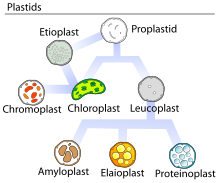Elajoplast
Elajoplast – bezbarwny leukoplast występujący w komórkach roślinnych. Gromadzi materiał zapasowy w postaci tłuszczów. Elajoplasty obecne są szczególnie często u wątrobowców i jednoliściennych[1].
Występują w organach przechowujących materiały zapasowe w postaci tłuszczów, między innymi w nasionach oleistych[2]. Obecność elajoplastów jest też charakterystyczna dla tapetum u wielu gatunków roślin[3][4][5][6]. W tapetum Brassica napus organellum zawiera liczne, małe krople lipidów, składających się głównie ze steroli i triacylogliceroli. Wewnątrz elajoplastów stwierdzono również obecność białek o masie 34 i 36 kDa. Wraz z tapetosomami są odpowiedzialne za powstanie powłoki lipidowej otaczającej dojrzałe ziarna pyłku[4].
Przypisy
- ↑ Jacek Godula: Elajoplast. W: Encyklopedia biologiczna T. 3.. Zdzisława Otałęga (red. nacz.). Kraków: Agencja Publicystyczno-Wydawnicza Opres, 1998, s. 138.
- ↑ Enrique Lopez-Juez, Kevin A. Pyke. Plastids unleashed: their development and their integration in plant development. „The International Journal of Developmental Biology”. 49 (5-6), s. 557–577, 2005. DOI: 10.1387/ijdb.051997el. ISSN 0214-6282 (ang.).
- ↑ F. Ciampolini, M. Nepi, E. Pacini, Tapetum development in Cucurbita pepo (Cucurbitaceae), t. 7, 1993, s. 13–22, DOI: 10.1007/978-3-7091-6661-1_2, ISSN 0172-6668 (ang.).
- ↑ a b Inmaculada Hernandez-Pinzón, Joanne H. E. Ross, Karen A. Barnes, Andrew P. Damant i inni. Composition and role of tapetal lipid bodies in the biogenesis of the pollen coat of Brassica napus. „Planta”. 208 (4), s. 588–598, 1999. DOI: 10.1007/s004250050597. ISSN 0032-0935 (ang.).
- ↑ Ettore Pacini i inni, Plastid Developmental Pathways in Some Angiosperm Reproductive Cells, 1992, s. 36–42, DOI: 10.1007/978-1-4612-2958-2_8 (ang.).
- ↑ Julie T. L. Ting, Sherry S. H. Wu, Chandra Ratnayake, Anthony H. C. Huang. Constituents of the tapetosomes and elaioplasts inBrassica campestristapetum and their degradation and retention during microsporogenesis. „The Plant Journal”. 16 (5), s. 541–551, 1998. DOI: 10.1046/j.1365-313x.1998.00325.x. ISSN 0960-7412 (ang.).
Media użyte na tej stronie
Plastids are responsible for photosynthesis, storage of products like starch and for the synthesis of many classes of molecules such as fatty acids and terpenes which are needed as cellular building blocks and/or for the function of the plant.

